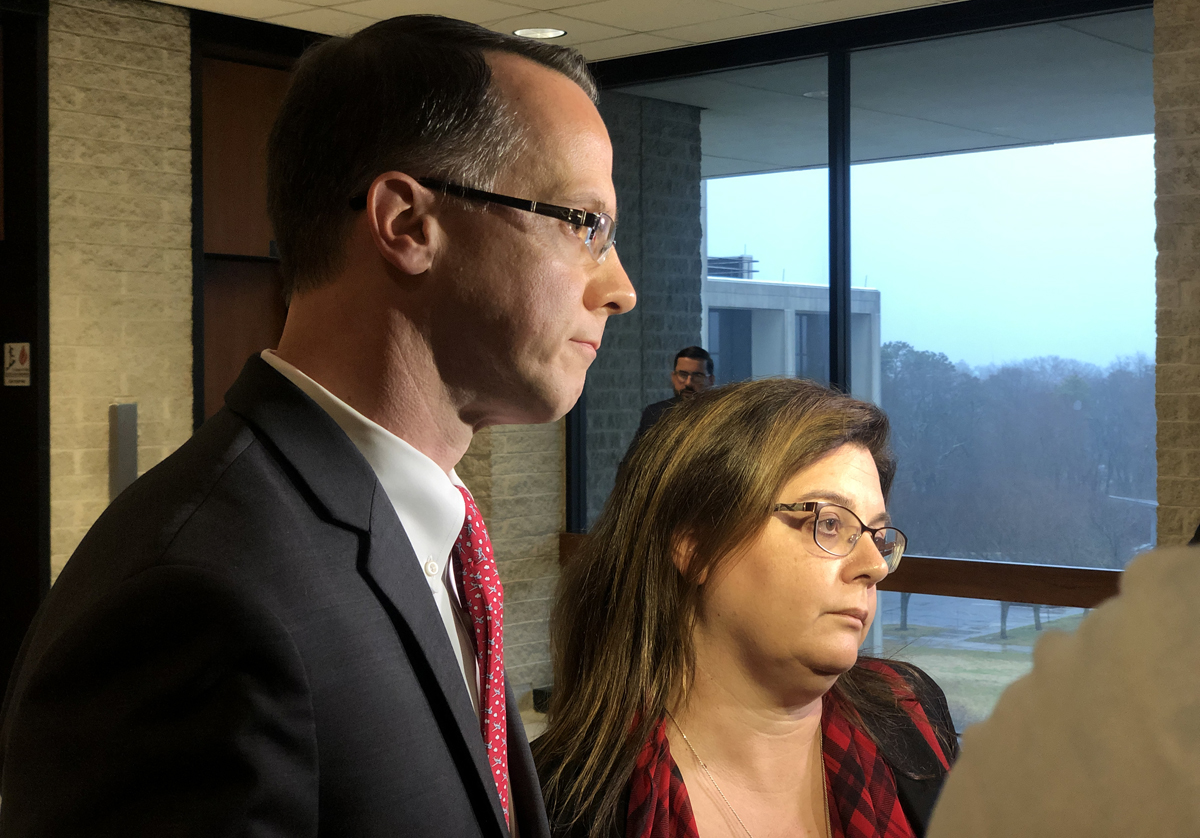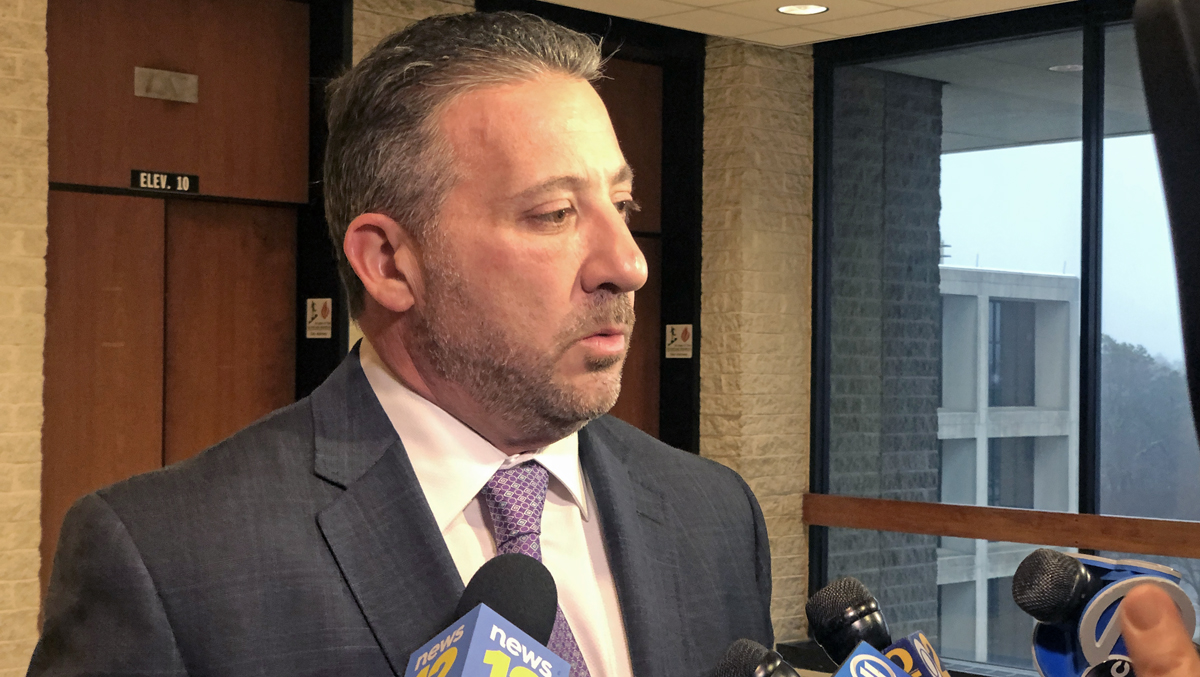Murphy defense begins to make its case as judge officially dismisses four charges

After 14 days of emotional testimony from prosecution witnesses in the case against Thomas Murphy — the Holbrook man accused of driving drunk and crashing into a pack of Boy Scouts last September, killing one and severely injuring another — the defense began to lay out its case Monday.
The first defense witness, Dr. Jimmie Valentine of Mississippi, a forensic toxicology expert and former professor at the University of Arkansas College of Medicine, told jurors there are several possibilities that could have led Mr. Murphy’s blood alcohol content to register at .13% nearly four hours after the crash on David Terry Road in Manorville.
During direct examination by defense attorney Steven Politi, Dr. Valentine suggested Mr. Murphy’s blood might not have been collected or stored properly. “There could be problems,” at the lab as a result, he said.
Mr. Politi quizzed Dr. Valentine on several factors that could influence the blood reading, including how Mr. Murphy’s arm was sanitized, whether or not the tubes containing Mr. Murphy’s blood were properly mixed with anticoagulant and preservatives, and whether microorganisms could have contaminated the sample and sparked fermentation.
David Reed, the physician’s assistant who drew Mr. Murphy’s blood at the seventh police precinct in Shirley, testified last week that he inverted the tubes eight times to properly mix the blood with the preservatives.
Besides accidental contamination, Dr. Valentine said it’s possible Mr. Murphy was carrying a bacterial or fungal infection that may have tainted his blood. That, paired with an elevated blood sugar level of 126 milligrams per deciliter the evening of the crash, makes it possible that microorganisms could grow and prompt fermentation to occur, turning blood sugars into alcohol and thus inflating the blood alcohol reading.
According to Dr. Valentine, .05% of alcohol can be produced for every 100 milligrams of glucose in blood as a result of fermentation, which could theoretically account for a portion of Mr. Murphy’s test result.
MORE TRIAL COVERAGE
Day 1: Prosecutors say Murphy turned down ride from sober friend moments before fatal crash
Day 2: Text messages, friend’s testimony tell a story of day of Scout crash
Day 3: Defense calls into question the character of key witness in Murphy trial
Day 4: Friends testify that despite drinking, Murphy did not appear drunk on day of crash
Day 5: Parents of surviving victims take stand
Day 6: Shoreham parent recounts moment of crash during testimony
Day 7: Jury sent home early as defense raises legal issue in Murphy trial
Day 8: Arresting officer testifies that Murphy showed signs of intoxication following crash
Day 9: Two more officers testify that Murphy was intoxicated on day of crash
Day 10: Two detectives take witness stand at Murphy trial
Day 11: Scientist who tested Murphy’s blood testifies it was over legal limit
Day 12: Toxicologist: Murphy’s BAC was twice legal limit; ordered to turn over notes
Day 13: Several charges could be withdrawn in case against Thomas Murphy
Day 14: Scout’s dad says ‘I ran as fast as I could’ to help son following crash
During his testimony, Dr. Valentine stressed the importance of the immediate refrigeration and chain of custody as it relates to forensic blood evidence. Mr. Politi has raised concerns with the five hours that elapsed before Mr. Murphy’s sample was delivered to the Medical Examiner’s office in Smithtown as well as who handled the blood.
Dr. Valentine agreed with Mr. Politi that “confirmation bias” could exist in the case, since Mr. Murphy’s sample was immediately labeled “DWI” and officials from the Suffolk County Police Department and District Attorney’s office communicated with the toxicologists in the Medical Examiner’s office.
“They introduce bias to the analyst,” Dr. Valentine said. “The analyst should be totally blind.”
He then pointed to several errors that could have been made throughout the testing process and presentation of gas chromatography data that “makes it look better than it actually is.”
The blood test’s margin of error, Dr. Valentine said, could put Mr. Murphy’s blood content lower, at 0.11%.
“The data I’ve looked at indicates a high likelihood that the sample analyzed was not giving the correct value,” he said.
During cross examination, assistant district attorney Brendan Ahern drew jurors’ attention back to Mr. Murphy’s behavior, slurred speech and other signs of intoxication testified about by previous witnesses.
“In a moving motor vehicle, one or two seconds can be all the difference between driving safely and being in a crash, right?” Mr. Ahern asked. Dr. Valentine agreed, acknowledging that alcohol can impact a driver’s inhibitions and reaction time.
Mr. Ahern referenced a series of videos Mr. Murphy shot on his iPhone an hour before the crash, where he can be heard telling his golf buddies how much he loves them and, as at least one friend testified, slurring his words. Dr. Valentine, who had not viewed the video footage or reviewed other witness testimony with regard to Mr. Murphy’s behavior, said that slurred speech typically begins to show at a BAC of .10% or higher.
Dr. Valentine said field sobriety tests only indicate clues of intoxication and agreed that gas chromatography is the “gold standard” used in the industry for forensic testing.
Several peer-reviewed academic journal articles referenced by Mr. Ahern Monday detail experiments where a blood’s container and storage conditions were not found to have a significant impact on blood alcohol content readings. “Most decreased over time,” Mr. Ahern said. He also cited a 2014 case in Nassau County, during which Dr. Valentine testified, that it would take two days for fermentation in blood to occur.
But in court in Riverhead Monday, Dr. Valentine said those experiments were likely done under sterile conditions, again suggesting Mr. Murphy could have been carrying an infection. He also clarified his 2014 remarks to say it would take two days for fermentation to peak in a sample.
Mr. Murphy’s blood was drawn Sept. 30, 2018, and tested the following morning, within 24 hours.

Outside of the courtroom, Alisa McMorris, whose 12-year-old son Andrew was killed in the crash, was joined in the gallery for the first time by her husband John, who finally testified in the case last week.
Ms. McMorris said Dr. Valentine’s testimony is a “terrible display of the loopholes” in the justice system.
“What’s going on in there is just a disgrace to our son’s death and all the boys that were hit,” she said.
Mr. McMorris said it’s “indisputable” that Mr. Murphy was drunk on the day of the crash.
“Words were not coming out of his mouth correctly … it was pretty obvious,” said Mr. McMorris, who testified to those beliefs on Thursday.
The couple told reporters that Andrew was paying attention during the hike and not running around as Mr. Politi has suggested.
“[Andrew] followed the rules and did not like it when other people didn’t follow the rules,” Mr. McMorris said. “He was a very good boy.”
Mr. Politi, also speaking outside of the courtroom, said the blood alcohol reading is “not to be trusted” and said fermentation is one of myriad factors that “add alcohol to the samples that aren’t in the human’s body.”

Judge dismisses four charges
As expected, Judge Fernando Camacho formally dismissed four charges included in Mr. Murphy’s original 16-count indictment that are based on his having had a blood alcohol content of .18 or more. They include felony counts of aggravated vehicular homicide, vehicular manslaughter and vehicular assault as well as a misdemeanor charge of aggravated DWI.
He indicated that he would reserve a decision on a motion by Mr. Politi to withdraw a reckless driving charge he says prosecutors have failed to prove. He scrutinized the prosecution’s choice to not call an accident reconstruction expert to testify.
“We never heard from him because they can’t prove it,” Mr. Politi told reporters. “Now, they’re hoping and they’re praying the jury just accepts the absolutely inconsistent testimony of just about every witness they called.”
The remaining 12 charges, including a top charge of aggravated vehicular homicide, will stand. The top charge carries a sentence of up to 25 years in prison.
Mr. Politi is expected to call at least one additional witness Tuesday. It’s not clear if Mr. Murphy will testify. Closing arguments could be held Thursday with the jury deliberating as soon as Friday.
[email protected]







